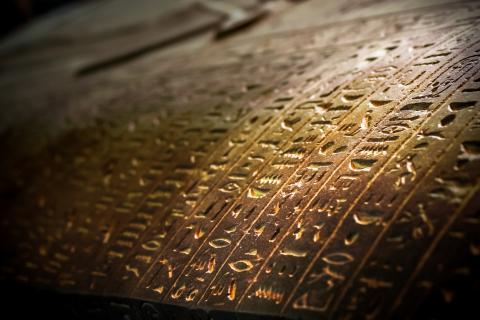
The Contemporary Relevance of Ancient Sciences
Alessandro Garcea, professor of Latin literature and History of texts, is the head of the Ancient Sciences initiative.

His ambition: to assemble the strengths of Sorbonne University based on field experience of archaeological missions and studies in ancient languages and cultures.
In what context was the Ancient Sciences Initiative created?
Alessandro Garcea: At Sorbonne University, we benefit from an extraordinary wealth of education and research related to the sciences of antiquity. However, the geographical and disciplinary fragmentation of these activities hinders their visibility. In 2016, a call for research university projects led us to think about a multidisciplinary training project involving all actors of the Faculty of Arts & Humanities.
This work served as the foundation for our Initiative, which today brings together three doctoral schools, five research units and the departments of History, Greek, Latin, Philosophy, History of Art and Archaeology. Our ambition today is to open this initiative to all three faculties of Sorbonne University.
What are its objectives?
A. G.: The objective is threefold. First, it is to unite the strengths of Sorbonne University dedicated to the study of Antiquity in an interdisciplinary dialogue of our knowledge. We want to create an intellectual community by building bridges between research units, doctoral schools and academic and research teams.
Second, we would like to de-compartmentalize traditional education and promote a pedagogical offer related to Antiquity that has no equivalent anywhere else. Better visibility and broadening of our existing educational program and will better display all our scientific activities.
Our third goal is to develop research projects in line with a broader vision of Antiquity by obtaining funding for educational and research projects, for invitations to international colleagues, for doctoral and post-doctoral contracts, as well as new types of publications.
What are the challenges in terms of research?
A. G.: Studying the sciences of Antiquity requires a transdisciplinary perspective. History, literature, art history, archaeology and philosophy are all part of the study of Antiquity. The way in which research in this field is carried out therefore requires notions of these different disciplines as well as in epigraphy, papyrology, paleography, and numismatics, sciences often considered as auxiliary and unknown by non-specialists.
Only an inclusive approach is capable of reflecting our whole student population, and more generally our contemporary society—we can still learn a great deal from Antiquity.
What are the challenges in terms of education?
A. G.: Our ambition is to give students the opportunity to follow a path that corresponds to their interests and current needs in terms of research and preservation of knowledge and heritage, both tangible and intangible.
For this purpose, we hope to create a new university degree in Ancient Science. This innovative program would complement the initial education of the students at the Sorbonne University Alliance who wish to deepen their knowledge in this field through a set of courses: initiation to digital humanities, modern sciences applied to archaeology as well as the study of ancient documents. It will provide them with a solid base of knowledge in ancient languages, history, literature, philosophy and art history. This university degree could also be open to museum curators, library managers or anyone who wishes to deepen their knowledge of Antiquity.
We have also set up, within the framework of the Initiative, the Sorbonne University School of Ancient Languages (Elasu), which offers courses in Ancient East and Antiquity languages. Elasu is part of our multilingual perspective, which is essential for understanding the evolution of languages, learning and translation practices, intercultural communication processes, etc.
Multidisciplinary approaches are at the heart of Sorbonne University’s initiatives. How are they manifested in yours?
A. G.: The intertwining of the humanities, hard sciences and medicine is becoming increasingly topical. Today we’re rediscovering, for example, ancient texts by Galen on the link between language and certain pathological states. These writings shed light on ideas that are still relevant today.
This is why we have chosen to fund several interdisciplinary projects as part of the Initiative. One of these deals with the history of biomedical traditions and the link between medical physiology and philosophy. This project, developed in partnership with the Biomedical Humanities Initiative, brings together philosophers of Antiquity, Hellenists, specialists in Ancient Greek medicine, and colleagues from the Faculty of Medicine.
We are also funding a project entitled "Palingenesis," which uses the new multi-spectral analysis tools developed at the Faculty of Science and Engineering to revive erased texts on Greek and Latin parchments.
Thanks to this multidisciplinary approach, we cover a wide range of subjects, and we encourage colleagues who also wish to do so to send us their proposals for research and education projects.
What impact can the Initiative have on society?
A. G.: Knowledge of the works of antiquity that have been passed down to us, and of the people who created them, involves taking into account knowledge that has developed over the last few decades into different disciplines. Transmitting this knowledge and preserving this heritage, both intangible and tangible, is essential for our cultural memory.
A more complete knowledge of the ancient world also enables us to shed light on our present civilization. Becoming aware of the diversity of languages, cultures, and religions that prevailed among the Ancients, of the plurality of identities in history, gives us food for thought about the vision we now have of places and people. This knowledge therefore forms part of the training of the critical mind.
